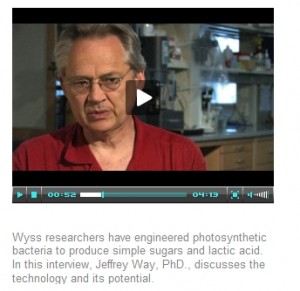Jul
7
Competition for Algae from Bacteria
July 7, 2010 | 7 Comments
Algae enjoy the highest potential of all the biological organisms for using sunlight to reform CO² and water into fuel products. But now scientists at Harvard’s Wyss Institute for Biologically Inspired Engineering have engineered photosynthetic bacteria to produce simple sugars and lactic acid. This innovation could lead to new, environmentally friendly methods for producing commodity chemicals in bulk.
The excitement comes from the possibility that bacteria can be developed so that the byproducts of living are what would be collected instead of the destruction of an organism to obtain the desired chemicals. That would allow a continuous production without the cycling with new organisms, growth, destruction of the organism and harvesting repeated over and over.
The Harvard University team has published their paper in the current issue of Applied and Environmental Biology. From the abstract:
“To address whether cyanobacteria could be engineered to produce and secrete organic primary metabolites, Synechococcus elongatus PCC7942 was engineered to express genes encoding an invertase and a glucose facilitator, which mediated secretion of glucose and fructose. Similarly, expression of lactate dehydrogenase- and lactate transporter-encoding genes allowed lactate accumulation in the extracellular medium. Expression of the relevant transporter was essential for secretion. Production of these molecules was further improved by expression of additional heterologous enzymes. Sugars secreted by the engineered cyanobacteria could be used to support Escherichia coli growth in the absence of additional nutrient sources. These results indicate that cyanobacteria can be engineered to produce and secrete high-value hydrophilic products.”
In other words, the Harvard bacteria are secreting sugar such as glucose and fructose with some lactic acid. Usually the bacteria would use the sugars as its food source, but here some energy is coming from light and the sugar production is maximized with the excess exiting out the cell membrane for collection.
In true environmental form the Harvard press release focuses on the use of industrial and power plants CO² emission for CO² inputs, but bacteria could as well just clean the air and be used across the planet. Sunlight for the energy input instead of the self produced sugars opens up a lot of potential.
Wyss Institute senior staff scientist Jeffrey Way, Ph.D. said, “What we’re doing is using genetic engineering to get organisms to act the way we want them to – in this case producing food additives. These discoveries have significant practical implications in moving toward a green economy.”
Are you wondering about the lactic acid? Lactic acid is a key building block for biodegradable plastic production. That means the yield could be fuels and chemicals.
This is an early press release on experimental data. The message is clear though – algae alone aren’t the whole of the highest productive available resources – bacteria as well can offer substantial advantageous.
The comparison between the two organisms is interesting. Algae can be expected for now, to remain the highest biomass producer by land area and the potential is in research to engineer algae for secretion of products so skipping beyond the destruction process cycle to harvest products. Algae remains for now, a very costly way to use sunlight to get fuels and chemical products.
Bacteria on the other hand, which secrete directly, offer great potential. The gene pool from which to build an organism is immense with innovation a sure thing for years to come. Coming out with secretion to start is a good indication of the route bacteria development can use. Moreover, bacteria would not be limited to CO² from the air or an effluent. One might expect that consuming bacteria might feed from a very large base of feedstocks, be it CO² gas to solid wastes.
Then there is the possibility of using both algae and bacteria together in a two-step process with for example light alcohol products. Algae might be used to reform the CO² for feedstock for bacteria.
Then looking longer out the bacteria might well yield fuel products such as alcohol directly. Maybe scientists will come up with symbiotic bacteria pairs with one using sunlight to make the sugar and another producing products. The possibilities are intriguing.
Today the payoff is the Harvard scientists have opened the door with the ‘how’ of getting bacteria to secrete what’s wanted – a significant point in developing biological processes for recycling carbon based fuels in an environmentally cooperative, friendly and productive cycle.
Comments
7 Comments so far



Excellent article.
[…] Competition for Algae from Bacteria | New Energy and Fuel […]
Great article! I think using organic sources of fuel (like algae and bacteria) is an excellent idea!
Here’s another article you may like on the topic:
http://www.scienceray.com/Philosophy-of-Science/Bacteria-Fuel.414157
Beneficial info and excellent design you got here! I want to thank you for sharing your ideas and putting the time into the stuff you publish! Great work!
Awesome post. I so good to see someone taking the time to share this information
Good! Thank you! I always wanted to write in my site something like that. Can I take part of your post to my blog?
Of course, what a great site and informative posts, I will add backlink – bookmark this site? Regards, Reader